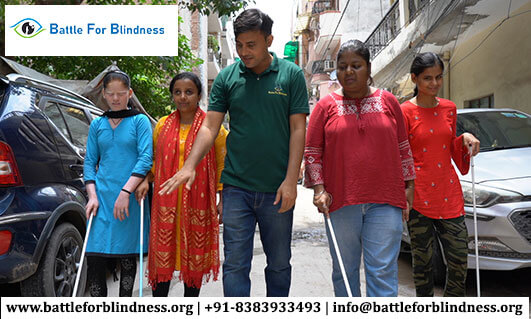
As the population ages, the world is becoming more aware of the challenges faced by the aging blind community. While much focus is placed on vision impairment in younger populations, it’s crucial to consider the needs of elderly individuals who are losing their sight. With a growing global elderly demographic, it’s more important than ever to build a supportive world for the aging blind to ensure their quality of life. This blog explores the importance of creating an inclusive and accessible environment for older individuals with vision loss and the steps we can take to help them navigate a world they can no longer fully see.
Understanding the Aging Blind Population
Blindness and vision loss don’t just affect the younger generation; they significantly impact older adults. According to the World Health Organization (WHO), age-related vision impairment, such as macular degeneration, cataracts, and glaucoma, is a leading cause of blindness in the elderly. As people age, they often experience gradual vision loss, which can be emotionally and physically challenging. For the aging blind, everyday tasks can become daunting, and they may face an increased risk of isolation and depression.
The aging blind community requires more than just healthcare solutions; they need a comprehensive support system that enhances their independence and dignity. This includes tailored services, assistive technologies, and a society built on inclusivity and accessibility.
The Importance of an Inclusive Environment
Creating an inclusive environment for aging individuals with vision loss goes beyond simply providing accommodations. It’s about fostering a world where they feel empowered, connected, and supported. This can be achieved by focusing on several key areas:
1. Accessibility in Public Spaces
One of the most critical aspects of building a supportive world for the aging blind is ensuring that public spaces are accessible. This includes the design of public transportation, sidewalks, and buildings with clear tactile signage, auditory cues, and adequate lighting. Simple adjustments, such as braille signs in elevators, textured floor patterns, and voice-guided navigation systems, can significantly improve the mobility of blind individuals.
2. Technology as a Lifeline
Assistive technology is a game changer for individuals with vision loss, particularly for the aging blind community. Advances in voice-controlled devices, smartphone applications, and wearable technology are helping blind seniors maintain their independence. Devices such as smart speakers, GPS-enabled wearables, and screen readers allow elderly individuals to perform daily tasks more effectively, whether it’s shopping, navigating public spaces, or connecting with loved ones.
Furthermore, technology can enhance communication for the aging blind. Video calls with speech-to-text services, audio books, and podcasts allow seniors to stay connected and informed.
3. Personalized Support and Care
Caring for the aging blind often requires more than just medical intervention. Personalized support services that focus on emotional well-being and social connection are vital. These services can include trained caregivers who are equipped with the skills to assist those with vision loss in daily activities, as well as support groups where the elderly blind can share experiences and form meaningful relationships.
4. Community Awareness and Education
Raising awareness about the needs of the aging blind population is essential in building a supportive society. Communities must be educated on the challenges faced by older individuals with vision loss, including the social isolation, physical barriers, and emotional strain they may experience. Training public service personnel, such as emergency responders, teachers, and healthcare workers, on how to assist blind seniors can make a significant difference in their daily lives.
5. Financial Assistance and Advocacy
Many aging blind individuals struggle with financial insecurity, especially if their vision loss hinders their ability to work or access affordable healthcare. Advocacy for accessible housing, financial assistance programs, and proper healthcare coverage is crucial for this population. Ensuring that aging blind individuals have access to the resources they need to thrive is a fundamental aspect of building a supportive world.
Creating a Future of Empowerment
It’s not just about vision loss—it’s about creating a future where aging blind individuals are empowered to live independently and confidently. This vision of a supportive world requires a shift in societal attitudes toward aging and disability. By promoting inclusivity in all aspects of life, from education to public infrastructure, we can build a future where the aging blind community is not just seen but truly supported.
Key Takeaways:
- The Aging Blind Population: The elderly population faces significant challenges due to vision loss, which can increase isolation and dependency.
- Inclusive Design: Accessibility in public spaces, such as tactile signage and audio cues, is essential to promoting independence.
- Assistive Technology: Innovations in tech, like smart speakers and GPS wearables, play a vital role in helping the aging blind live independently.
- Community Support: Personal care services, social connections, and emotional well-being are critical for seniors with vision loss.
- Financial and Advocacy Support: Access to financial assistance and healthcare is necessary to ensure a dignified life for aging blind individuals.
Conclusion: Building a World Beyond Vision
The aging blind community deserves more than just survival—it deserves to thrive in a world that is supportive, inclusive, and accessible. By investing in assistive technologies, creating accessible spaces, providing emotional and financial support, and raising awareness, we can build a future where aging blind individuals are empowered to live fulfilling lives. It’s time to move beyond vision and work together to create a world that sees the abilities of the aging blind, not just their challenges.





